Documentary ‘Croatia: Defining A Nation’ Wins AIPS Sport Media Award
May the 11th, 2023 - A documentary film titled ‘Croatia: Defining A Nation’ has won at the fifth edition of the AIPS Sport Media Awards, held in the capital of South Korea on Tuesday.
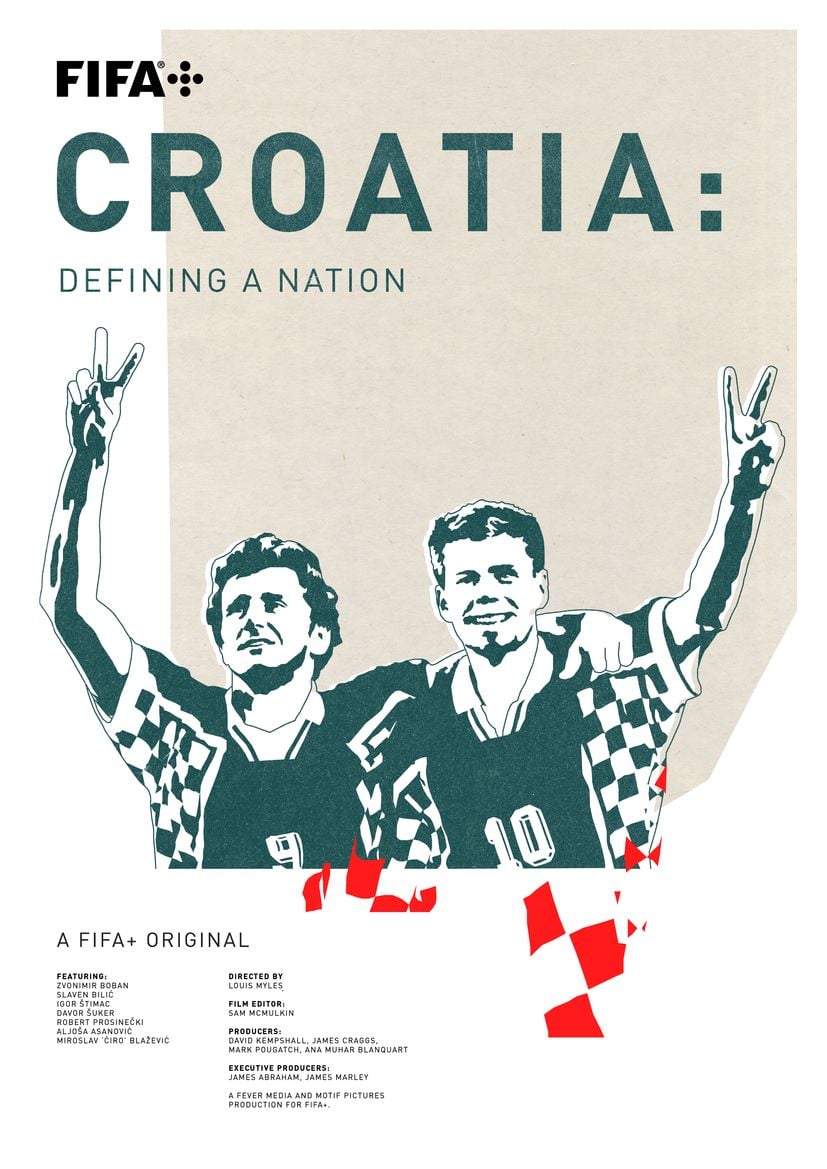
The film is by award-winning British filmmaker Louis Myles (Kaiser: The Greatest Footballer Never to Play Football, Liverpool FC: The 30-Year Wait), alongside producers Mark Pougatch and Ana Muhar Blanquart, David Kempshall and James Craggs.
“Thanks to all the people that helped us to make a film like this, and to all the people that talked about and remembered a difficult past. Massive appreciation to all of them,” said Myles.

The film is a truly inspirational story of the national football team from its fiery beginnings and how the power of football helped unite a nation during the extreme adversity of Croatia’s fight for political independence during the 1990s. It follows the path of Croatia off the pitch, but also a group of players whose lives were intertwined with the birth of the nation through the great success they achieved.
Featuring in-depth interviews with former Croatian national team players who became synonymous with this period in football and political history, including Igor Štimac, Slaven Bilić, Davor Šuker, Robert Prosinečki and Zvonimir Boban, the 'Croatia: Defining a Nation' documentary showcases how football players carried their nation's hopes on their shoulders - promoting Croatia to the world as it fought hard for its independence. And when the fighting finally ended, their talent on the football pitch brought joy to their people - establishing the identity of the country, and the blueprint for all that followed them.

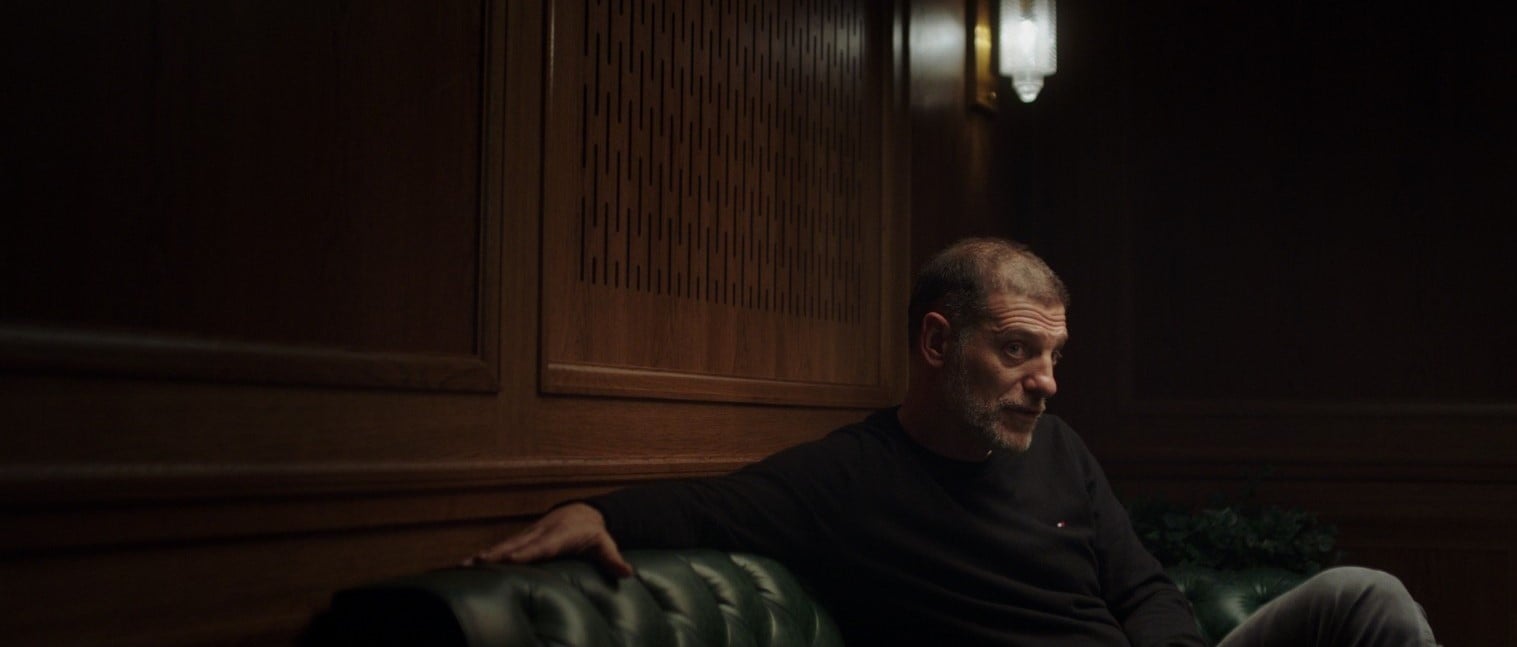

‘Croatia: Defining A Nation’ won in the Video Documentary category, beating Benjamin Unger’s ‘Olympics 1972: The GDR and the terror – NDR’ and ‘The Figo Affair: The transfer that changed football’ by David Tryhorn. It is available across all web and mobile devices on the FIFA+ platform. It is available in five language editions (English, Spanish, French, German and Portuguese) and also has Croatian subtitles.
Watch the film HERE.
Superb to win First place for best documentary at the AIPS awards for Croatia: Defining a Nation at the AIPS awards in Seoul tonight.
— Louis Myles (@louismyles) May 9, 2023
Many thanks to the many people who make this stuff actually happen. https://t.co/KERgE4ERqD
For more, make sure to check out our dedicated sport section.
The Vegliot Dialect - The Krk Romance Language Extinct Since 1898
January the 23rd, 2023 - The Vegliot dialect, which is also often referred to as Vegliotic, is a now extinct Romance language once spoken on the island of Krk. The last speaker of the Vegliot dialect was Antonio Udina (Tuone Udaina), who passed away in June 1898. Little is known about the dialect named after the Italian name for Krk (Veglia).
We've explored many of the dialects, subdialects and indeed languages in their own right as some linguists consider them to be which are spoken across modern Croatia. From the Dubrovnik subdialect (Ragusan) in the extreme south of Dalmatia to Northwestern Kajkavian in areas like Zagorje, the ways in which people speak in this country deviate from what we know as standard Croatian language enormously. That goes without even mentioning much about old Dalmatian, Zaratin, once widely spoken in and around Zadar, Istriot, or Istro-Venetian.
A brief history of the Vegliot dialect
Of the now extinct languages once spoken on modern Croatian territory, we've looked into Istrian-Albanian, which became extinct in the nineteenth century after being introduced to parts of Istria by ethnic Albanians settled there by Venice who spoke in the Gheg (or Geg) variety of modern Albanian. Now we'll jump back into our linguistic time machine and head back into the island of Krk's past, during which the Vegliot dialect was spoken all the way until June 1898, when the last person to speak it died.
As mentioned above, the Vegliot dialect is named after the Italian name for Krk - Veglia, and its closest ''relative'' is believed to be Istro-Romanian, another Romance language once spoken more widely spoken across the Istrian peninsula, more precisely in the nothwestern parts near the Cicarija mountain range. There are two groups of speakers despite the fact that the language spoken by both is more or less absolutely identical, the Vlahi and the Cici, the former coming from the south side of the Ucka mountain, and the latter coming from the north side.
This language has been described as the smallest ethnolinguistic group in all of Europe, and without a lot more effort being put into preservation, the next few decades to come will almost certainly result in the complete extinction of the Istro-Romanians and their language.
A Western Italian dialect of Dalmatic, the Vegliot dialect was once spoken by a group of Morlachs (pastoralists) who were engaged in herding. As each of these individuals passed away, the last remaining was speaker was the aforementioned Antonio Udina, who was often affectionately called Burbur.
Antonio Udina (Tuone Udaina)
Udina was born in 1823 on the island of Krk, and died on June the 10th, 1898, losing his life in a road mine explosion and taking the Vegliot dialect with him into the beyond. Nicknamed Burbur, Udina is deemed the last person to fluently speak in the Vegliot dialect, but he was in actual fact not a native speaker of this language. He had learned the dialect (or language, for argument's sake) from his parents who both hailed from the island of Krk and spoke it as their native tongue.
Well known Italian linguist Matteo Bartoli wrote a paper on Dalmatian/Dalmatic language(s) way back in 1897, in what was to be the final full year of Udina's life. At that time, Udina had not spoken in that language for around twenty years, and he had also suffered dental issues so severe they had affected the movements of his mouth and as such he speech, and on top of that - he was also deaf.
Despite being deemed the last speaker of the Vegliot dialect, he is not considered a reliable source in regard to this language owing to his health issues. That said, after Udina was killed in a road mine explosion, the Vegliot dialect also died and is unlikely to ever be heard again.
For more on the Croatian language and the many dialects and subdialects spoken across this small but diverse country, make sure to check out our lifestyle section. An edition on language is published every Monday.
Exploring Croatian - A Brief History of the Istro-Romanian Language
November the 28th, 2022 - Have you ever heard of any Balkan-Romance languages other than Romanian? Unless you happen to be a linguist, the term is probably somewhat alien to you, especially given the fact that the languages spoken across much of the region (but not all of it) are Slavic. Let's get better acquainted with the sparsely spoken Istro-Romanian language.
We've explored many of the dialects, subdialects and indeed languages in their own right as some linguists consider them to be which are spoken across modern Croatia. From the Dubrovnik subdialect (Ragusan) in the extreme south of Dalmatia to Northwestern Kajkavian in areas like Zagorje, the ways in which people speak in this country deviate from what we know as standard Croatian language enormously. That goes without even mentioning much about old Dalmatian, Zaratin, once widely spoken in and around Zadar, Istriot, or Istro-Venetian.
Istria in particular is full of culture, and its rather complex historic relationship with Italy and in particular with the formerly powerful Venice has a lot to answer for in this regard. That brings us to a language that actually has nothing to do with Venetian, and is only spoken by people who call themselves Rumeni or sometimes Rumeri. It can only now be heard in very few rather obscure locations and with less than an estimated 500 speakers of it left, the Istro-Romanian language is deemed to be seriously endangered by UNESCO's Red Book of Endangered Languages.
Who are the Istro-Romanian people?
The Istro-Romanians are an ethnic group from the Istrian peninsula (but they aren't necessarily native) and they once inhabited much of it, including parts of the island of Krk. It's important to note that the term ''Istro-Romanian'' itself is a little controversial to many, and most people who identify as such do not use the term, preferring instead to use the names taken from their villages. Those hamlets and small settlements are Letaj, Zankovci, the wider Brdo area, Zeljane, Nova Vas, Jesenovik, Kostrcani and Susnjevica.
Many of them left to begin their lives in either larger Croatian cities or indeed in other countries as the industrialisation of Istria in the then Yugoslavia progressed at a rather rapid pace. Following Istrian modernisation which had enormous amounts of resources pumped into it by the state, the number of Istro-Romanian people began to dwindle rather significantly, until they could only really be found in a handful of settlements.
The origins of the Istro-Romanian people are disputed, with some claiming they came from Romania, and others claiming that they arrived originally from Serbia. Regardless, they have been present in Istria for centuries and despite efforts from both the Romanian and Croatian governments to preserve their culture and language - the Istro-Romanian people are still not classed as a national minitory under current Croatian law.
Back to the Istro-Romanian language
Like many dying languages, the Istro-Romanian language was once much more widely spoken across the Istrian peninsula, more precisely in the nothwestern parts near the Cicarija mountain range. There are two groups of speakers despite the fact that the language spoken by both is more or less absolutely identical, the Vlahi and the Cici, the former coming from the south side of the Ucka mountain, and the latter coming from the north side.
Back in 1921, when the then Italian census was being carried out, 1,644 people claimed they were speakers of the Istro-Romanian language, with that figure having been deemed to actually be around 3,000 about 5 years later. Fast forward to 1998, the number of people who could speak it was estimated to stand at a mere 170 individuals, most of them being bi or trilingual (along with Croatian and Italian).
The thing that will be sticking out like a sore thumb to anyone who knows anything about language families - the fact that this is called a Balkan-Romance language. While it is classified as such, the Istro-Romanian language has definitely seen a significant amount of influence from an array of other languages, with approximately half of the words used drawing their origins from standard Croatian as we know it today. It also draws a few from Venetian, Slovenian, Old Church Slavonic and about 25% or so from Latin.
Istro-Romanian is very similar to Romanian, and to anyone who doesn't speak either but is familiar with the sound, they could easily be confused. Both the Istro-Romanian language and Romanian itself belong to the Balkan-Romance family of languages, having initially descended from what is known as Proto-Romanian. That said, some loanwords will be obvious to anyone familiar with Dalmatian, suggesting that this ethnic group lived on the Dalmatian coast (close to the Velebit mountain range, judging by the words used) before settling in Istria.
Most of the people who belong to this ethnic group were very poor peasants and had little to no access to formal education until the 20th century, meaning that there is unfortunately very little literature in the Istro-Romanian language to be found, with the first book written entirely in it having been published way back in 1905. Never used in the media, with the number of people who speak it declining at an alarming rate and with Croatian (and indeed Italian) having swamped Istria linguistically, it's unlikely you'll ever hear it spoken. Some who belong to this ethnic group who live in the diaspora can speak it, but that is also on a downward trajectory.
This language has been described as the smallest ethnolinguistic group in all of Europe, and without a lot more effort being put into preservation, the next few decades to come will almost certainly result in the complete extinction of the Istro-Romanians and their language.
For more on the Croatian language, dialects, subdialects and history, make sure to check out our dedicated lifestyle section.
Losinj Gets First Sculpture Dedicated to Wives of Croatian Seamen
September the 17th, 2022 - Losinj has become home to the very first sculpture dedicated to the wives of Croatian seamen, who would be frequently seen down by the shoreline waving goodbye to their men heading off to sea.
As Morski writes, when every vessel set sail from the Port of Losinj for a long journey, it would dock in one of the most beautiful coves there - Cikat bay near the church, where the crew would disembark and pray with their families in the church before parting.
The "ADDIO" sculpture dedicated to the wives of Croatian seamen was created as a symbol of tradition, but also of love and loyalty. The bronze sculpture, which stands at a height of 178 cm, found its place exactly in the same place where Losinj's local wives used to wave goodbye to their sailor husbands many, many years ago. It is dedicated to Marija Stuparic, the wife of Captain Aldebrand Petrina, who waved to him as he sailed off into the distance. "Goodbye, my beloved!" she said into the wind while waving a white handkerchief to the sailing ship that was disappearing over the horizon.
After that, she would return to the small church of the Annunciation of Mary (Annunziata) to pray once more for her husband's eventual safe return. The Initials M.S. on the facolic (handkerchief) belong to her, and she was considered to be a dear woman, the wife of Captain Aldebrand Petrina. During their 32 years of married life, they spent only 13 months together in their home in Losinj. Sailors' wives had to be strong-minded, persistent, patient and ready for anything to occur.
''Our desire was to pay tribute to all the sailors' wives who saw Croatian seamen off on their journeys and waited for their return home in an attractive, modern and somewhat abstract way. The form of a classical sculpture has been retained but with a silhouette, and it is somewhat more airy and unique. The sculpture is life-size, on the back is a motif that used to be found on the headbands of women from Losinj, and which can be seen in our permanent exhibition,'' explained the director of the Losinj Museum, Zrinka Ettinger Starcic.
Academic sculptor and the creator of this new Losinj sculpture, Zvonimira Obad, explained the artistic interpretation of the sculpture.
''This is the shape of a woman and it is layered and lost in space, showing how she is being "carried away by the wind". The idea comes from the symbol of a tradition that is falling into oblivion, all for the purpose of "retaining" the time that has passed and renewing the feeling of belonging. The "Addio" sculpture is a symbol of both love and fidelity,'' according to author Obad.
''In this way, we're helping to preserve another valuable memory of our rich maritime past,'' said the director of the Tourist Board of the Town of Mali Losinj, Dalibor Cvitkovic.
For more, make sure to check out our dedicated lifestyle section.
Fifteen Years Pass Since Devastating Kornati Tragedy
August the 30th, 2022 - Fifteen whole years have passed since the devastating Kornati tragedy took the lives of twelve out of the 23 firefighters sent to the island of Kornat to battle the wildfires that had broken out there on the 30th of August, 2007.
A series of horrendous wildfires broke out between June the 1st and August the 8th, 2007, and the period is even referred to as the 2007 Croatian coast fires. The fire which broke out on the island of Kornat, part of the heavily visited Kornati National Park, became the horrific scene of the worst Croatian firefighting accident in the history of firefighting in this country.
As Morski writes, twelve tremendously brave and selfless firefighters lost their lives either at the scene on the island of Kornat, or died later on when in hospital. The only survivor at that time was 23-year-old Frane Lucic from Tisno.
In Vodice, the commemoration of another sad anniversary of the Kornati tragedy began with a parade of local fire brigades. The pilots of the 855th firefighting squadron of the HRZ also paid their respects to the firefighters with a canadair flight over the town, writes HRT.
At the monument to the victims, a model of the helicopter that flew over the Kornati National Park on the fateful day, as well as the black box from that aircraft, which was subsequently lost, were placed.
''Our message that we wanted to showcase with this is that the black box was removed from the helicopter and was lost on the day of the accident and it has still not be found, fifteen years have now passed and the question arises as to why it even disappeared in the first place,'' said Matija-Karlo Valincic, president of the Vodice Fire Brigade.
Some of the families of the fallen firefighters who lost their lives to the fire that day still think that they were doused with kerosene from a helicopter. Officially, according to experts, the Kornati tragedy was caused by different versions of a "rare natural phenomenon" - an eruptive fire, the combustion of an inhomogeneous gas mixture and a fire with an eruptive effect. In the case against former fire chief Drazen Slavica, the court rejected the possibility that the firefighters died due to the effects of kerosene. In the meantime, Slavica has been legally acquitted and will now sue the state.
Despite the passage of time and the chances of getting answers seeming to get further and further away as the clock ticks, the families whose lives have been stuck in summer 2007 ever since the Kornati tragedy aren't giving up on their search for the truth and for justice. They have jointly submitted a constitutional complaint and requests to the European Court of Human Rights.
For more, make sure to check out our dedicated lifestyle section.
Croatian Socialist Past Responsible for Lower Wages? Analysis Says Yes
August the 14th, 2022 - Is the Croatian socialist past responsible for the big wage gap between the country and other European Union member states which were never part of Yugoslavia? One Croatian Employment Service (HZZ) analysis says an emphatic yes.
As Marija Brnic/Poslovni Dnevnik writes, the growth of wages over the last year has been mostly attributed to the chronic lack of workers in Croatia, but calls are regularly heard from the ranks of Croatian businessmen to the government to undertake tax reforms and finally reduce the high burdens due to which workers' wages are low compared to other countries, and their products are as such very uncompetitive.
In recent statements, they warned that 42% of an employee's gross salary goes straight to the state. However, an analysis of the Croatian Employment Service (HZZ) on the average gross wages in the manufacturing industry across EU member states shows that the level of wages and indeed large differences between EU countries is also determined by a number of other elements that determine labour productivity, and the most interesting conclusion they've drawn is that such differences are greatly influenced by the legacy of socialism.
The Croatian socialist past - Life behind the "Iron Curtain"
This fact can be seen at first glance from the very ranking of wages paid per hour of work by industrialists in certain other countries, because they are the highest among the older EU member states, while the countries behind the former "Iron Curtain", including Croatia, come second with gross salaries which are several times lower.
According to Eurostat data for 2021, the highest gross hourly wage is paid in Denmark (48.5 euros), while the lowest (5.8 euros) in Bulgaria is 8 and a half times less. Workers at processors in Belgium, Sweden and Germany had more than 40 euros in gross hourly wages, and almost 40 euros is paid out per hour in both Austria and France.
Among the former socialist countries, the highest gross wages are paid to employees in neighbouring Slovenia (20.3 euros), which is twice as much as in Croatia, where an hour of production costs an average of 10.3 euros. Industrial workers in the Baltic country of Latvia also have a very similar gross salary, and only salaries in Romania, along with Bulgaria, are lower than that.
This trend, although CES analysts refrain from drawing firm conclusions since the past two years we've all been operating under the conditions of a global coronavirus pandemic, shows that in most countries the price of labour in industry has increased, and this is most visible in hourly rates in Denmark and Sweden, while in some countries, slight reductions were also recorded.
Here in the Republic of Croatia back during the pre-pandemic year of 2019, the average gross hourly wage stood at 10.1 euros, a year later it stood at 9.9 euros, and last year it rose to 10.3 euros.
Due to the unreliability of the data from the time of the unprecedented situation involving the spread of the novel coronavirus, CES analysts based their further research on wage differences on 2019, i.e. data on what affected labour productivity, and thus wages, in the period from 1996 until that time. The data on the share of experts and the share of technicians in the total number of employees were also compared, and they also processed data on the extent of investments in machines and equipment during that longer period.
Impacts on productivity
It has been shown that Finland (23.8%) and Luxembourg (229%) have the largest share of experts in the total number of employees in the processing industry, while Sweden (24.8%) and France (24.6%) lead the way in terms of the share of technicians, Belgium leads in terms of industrialists (305,000 euros per worker) and Sweden (262,500) in terms of relative investment in machinery and equipment.
Former socialist countries are at the bottom again - Slovakia in terms of the share of experts (3.6), Romania in terms of the number of technicians (4.5), and Bulgaria in terms of investments in machinery and equipment (34,200 euros per worker). In Croatia, 7.6% of the employees in the industry are experts, 12.3% are technicians, and the average investment per worker was 60,000 euros.
CES analysts calculated that the share of specialists in the total number of employees, higher by one percentage point, increases wages by 3.7%, and the share of technicians by 2.7%. In the case of investments, the ratio of logarithmic values shows that investments are higher by 10%, with an unchanged share of experts and technicians, associated with a higher salary level by 5.7%.
It is clear that part of today's wage differences very likely reflect the historical handicap of countries that were once socialist, and as such the Croatian socialist past should as such be taken into account. CES analysts pointed out that according to their calculations, the historical legacy of socialism reduces today's wages in the industry sector by a not at all insignificant 21% in total.
For more, make sure to check out our dedicated politics and business sections.
What Did Marvelous Mrs. Maisel Get Wrong About Croatia?
July 31, 2022 - In one of the least important articles ever posted on this site, we examine a brief conversation in the TV series 'Marvelous Mrs. Maisel' which features Croatia as a plot point.
Disclaimer no. 1: Yes, I know I'm late. The episode I'm talking about here, the 7th episode of the fourth season of the Amazon Prime Video series, was released in March, but hey, there are so many shows to see, so little time!
Disclaimer no. 2: Total Croatia News is a serious site, bringing you the most important news about Croatia in the English language. However, please keep in mind that my biggest (potentially only?) claim to fame is the fact that my article from a long time ago is still cited on a Wikipedia page for a TV show that has since won 9 Emmys, and is currently nominated for 25. Don't believe me? See for yourself, it's reference no. 89 in the article!)
So, Marvelous Mrs. Maisel is a TV show about a newly divorced lady from New York, who decides to pursue a career in stand-up comedy - in the late 1950s and the early 1960s! It has had a very successful run of 4 seasons thus far, created by Amy Sherman-Palladino (of the Gilmore Girls fame), and starring the amazing Rachel Brosnahan as the title character, Midge Maisel.
In the aforementioned episode seven of season four, Midge has a conversation with Susie, her manager (played marvellously, pun intended, by Alex Borstein). Previously in the season, Midge has decided she doesn't want to open for anyone else, under any circumstances, and that she only wants to do shows where she'd be the headliner. Susie brings her the good news:
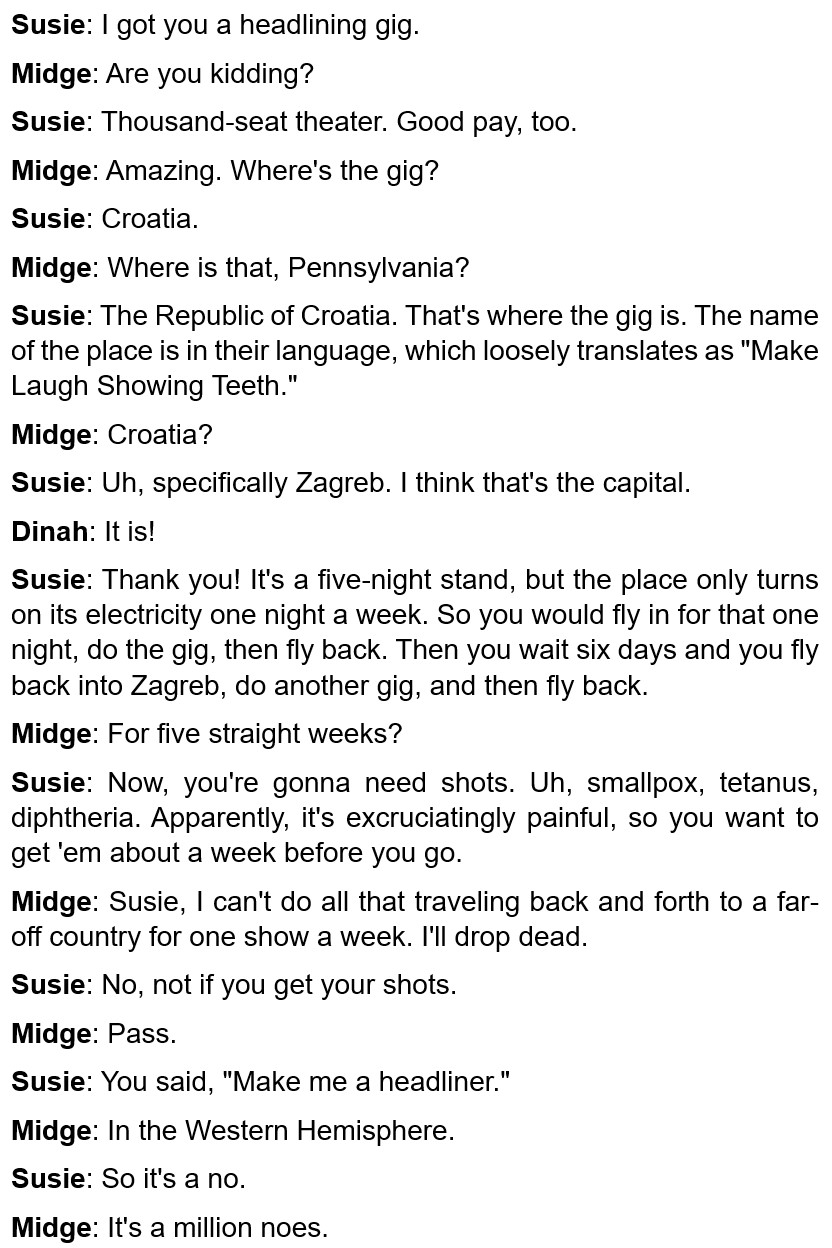
Now, don't get me wrong: I get the point, I get the joke! But, many of my online friends have asked me, and I've since found out that there've been discussions about the mention of Croatia in this context. Important point: we know exactly when this episode is taking place, as it includes a long scene of Midge doing a performance at one of John F. Kennedy's campaign events. And as we know, he was elected to become the US President in November of 1960, so we can timestamp the episode as "during 1960".
So, let's go point by point, and untangle this mess:
- Was there a 'Republic of Croatia' in 1960? Well, that's a "yes" and a "no" at the same time. The People's Republic of Croatia was a part of the Federal National Republic of Yugoslavia between 1945 and 1963, when the new constitution was instituted (after 1963, it was the Socialist Federal Republic of Yugoslavia and the Socialist Republic of Croatia". Constitutions are complicated, obviously, but would anyone say that they were going to Croatia in 1960? Not very likely, unless they had close ties to the country. Would you say you were going to Montana now, if anyone asked you? Probably not, you'd say you're going to the USA, and then the next question might be about the state where you're going to.
- Was Zagreb the capital of Croatia then? Yes, absolutely. It has been the capital of Croatia (at least!) since 1918, when it joined the Kingdom of the Serbs, Croatians and Slovenians (later to be renamed the Kingdom of Yugoslavia), although the Croatian Parliament has been seated in Zagreb since 1825. So, nothing wrong there, Zagreb was the capital.
- Is there any link whatsoever between Croatia and Pennsylvania? Actually, yes. There is a huge Croatian community in Pittsburgh (and the rest of Pennsylvania), and that's where the Croatian Fraternal Union was established.
- Was there a thousand-seat theater in Zagreb in 1960? No, not really. The Vatroslav Lisinski Concert Hall was the first such venue in Zagreb. It was decided that it would be built in 1957, the works on it started in 1961 and it wasn't finished until late 1973. Before that, except for a football stadium, there were no venues in the city of Zagreb with such a capacity.
- Does "Make Laugh Showing Teeth" mean anything to anyone in Croatia, when translated? Absolutely not. I would love to know how and where the scriptwriters got the idea to give that name to their imaginary venue. No matter how you translate that to Croatian, there has never been a place called anything similar to that.
- Were there electricity problems in Croatia in the 1960s? Also, that's a resounding "No!" The former Yugoslavia, and therefore, Croatia, was very stable during that period. Stuck in a position best described as "no-man's land" during the Cold War, the Tito government was borderline pampered by both the Soviets and the Western powers in that period. Croatia was experiencing a cultural and economic boom in that period, as stated by the historians Tvrtko Jakovina and Dušan Bilandžić in their piece you can access here (.pdf, in Croatian). The economy was doing OK, and there were cultural breakthroughs that made Zagreb one of the centres of culture in Europe during that period (Modern Arts Gallery, International Festival of the Student Theatre, Animated Film Festival, Ivo Robić and his international hit "Morgen"* all happened at the time). The country has seen electricity rationing, but it happened 20 years later - in the period after 1983, the electricity was rationed in Zagreb (the so-called "redukcije", that this author is old enough to remember) and in other major towns in the former Yugoslavia. However, even when those happened, it was not "one night of electricity, six nights without", rather - we didn't have electricity twice a week. If my memory serves, it was on Tuesdays and Thursdays. So, there would be no reason for Midge to travel in and out of the country each week, she could've had 7 shows a week in the sixties, and 4 or 5 shows a week even during the worst period of austerity before the Homeland War.
- What about those freakin' shots? I'm not sure. Honestly, there's only so much research one can do for a piece such as this one. I don't know, and can't easily find out which vaccines the USA citizens needed in 1960 to go to the former Yugoslavia and get back (and honestly, I doubt that the screenwriters did any more research than I did). However, there are two points I'd like to make regarding the vaccinations mentioned:
- as anyone who's recently stepped on a nail or was bitten on the chin by their dog can tell you, the tetanus vaccination is a normal thing we should all take when needed, and it's not 'excruciatingly painful';
- there was a smallpox outbreak in the former Yugoslavia in 1972, it's well-documented and written about. There's even an amazing movie about the outbreak, and you should watch it if you haven't already. However, that's more than a decade after the events of the episode we're talking about, and the smallpox threat was not considered to be high, so I'm not convinced that US citizens would need to be vaccinated against the disease for travel. I do know that the children in the former Yugoslavia were vaccinated against smallpox almost until the end of the seventies, to make sure that we don't have another outbreak.
So, not having lived in Zagreb in 1960, what do I think, would it be the worst thing in the world for the Marvelous Mrs. Maisel to perform here? No, I honestly don't. There was electricity, there were people who'd be interested in seeing her perform, but unfortunately, there wasn't a thousand-seat theatre for her to perform in, especially not one called "Make Laugh Showing Teeth" or any version of that name.
* - featured in another international TV hit this year, Natasha Lyonne's second season of Russian Doll, as shown below:
WTF RUSSIAN DOLL LOL pic.twitter.com/Wj2danfi2f
— ušesluh (@usesluh) April 21, 2022
Did You Know That Pirovac Was Called Zloselo (Evil Village) Until 1930?
July the 11th, 2022 - Croatian history is turbulent, often violent, and is as rugged as the landscape itself. But wars, changes of state and changes of often rather brutal regime aside, it's also absolutely full of strange little stories like this one. Did you know that Pirovac was called Zloselo (which literally translates to evil village) until 1930?
As Morski/Ivo Glavas writes, When looking at how Pirovac was once referred to back in April 1930, you might find yourself raising an eyebrow or two...
"As is known, recently, at the request of the village of Zloselo in the Municipality of Tijesno in the Sibenik region, it was decided by decree to replace the name of the respective village with the name of Pirovac, which is older and belongs more to the national past of that region, since the name of Zloselo was given during the time of the struggle with the Ottomans (Turks), i.e. during the time of Venetian rule."
That's how they talk about the great ceremony at which on April the 23rd, 1930, the inhabitants of the former Zloselo changed the name of their settlement to Pirovac. This was reported on by a local Split newspaper called Novo doba (New age). On that day, a commemorative plaque was placed above the entrance to the settlement, which is part of the former defensive wall from the time of the long battles with the marauding Ottomans.
In this way, the people of Pirovac scrapped the name of the settlement that was of course, not pleasant at all to their ears. Who would want to tell people they're from the evil village when asked? The real truth about the name of their settlement is quite different and, as it always happens, buried a little deeper in history, local portal SibenikIN writes.
The local people of Pirovac were brave and cunning and doggedly determined to defend their homes from the Ottoman invaders, but they were few in numbers compared to the Turkish forces. That's why in a small group, headed by a local captain, they left their defensive fort and ambushed a Turkish officer. Thinking that there were many of them coming to attack them, the Turks ran away shouting: "Evil village, evil people!"
This is how the origin of the name Zloselo is explained on the official website of the Municipality of Pirovac. However, it's of course not the only settlement in the Republic of Croatia and elsewhere in Southeastern Europe with the prefix ''evil''. None of these other names have anything to do with the Ottomans or with their invasion.
Zlopolje (evil field), for example, is the name for fertile fields on the Dalmatian islands of Vis, Korcula and Lastovo. Velo and Malo Zlopolje on the island of Vis are part of the Vis area known for the popular Vugava grape variety. On the first Austrian cadastral map of the island of Vis from the first half of the 19th century, there were already vineyards there. The name Zlopolje hardly outlines the character of that part of the area. As we've also seen, the easiest thing to do is to blame the Ottomans for, well... just about everything, even in situations and in locations they've never been in.
The oldest historical record we've found that mentions Zloselo (which is now Pirovac) dates all the way back to 1460. At that time, some Vlaska families, by contract with Sibenik nobles from the Tomasevic and Misic families, settled in the village of Zloselo. Therefore, Zloselo had existed under that name since some time before 1460, which was again before the serious penetration of the Ottomans into Dalmatia and the territory of Sibenik. In an ownership dispute back in 1505 between the then owner of Zloselo, Sibenik noble Petar Draganic, and the Bishopric of Sibenik, witnesses claimed that Zloselo as a settlement was founded 50 years ago, i.e. somewhere around the year 1450. Therefore, when all the aforementioned historical data is carefully analysed, Zloselo, or should we say Pirovac to be polite, was most likely founded by Sibenik nobleman Toma Tomasevic sometime during the first half of the 15th century.
If that's the case, where did the name Pirovac actually come from? This question can be answered in the same historical document from way back in 1460, because according to that document, Pirane is the former name for Pirovac. Later on in history, in archival documents, the names of Pirane and Zloselo were exchanged for the current Pirovac.
There were also other locations called ''Zloselo'' close to Sibenik near what is now Zaton...
Looking back in time, there was another Zloselo on the territory of medieval Sibenik, somewhere in the western part of Zaton. Those locations called Zloselo were also founded in the 15th century.
The story of Pirovac and Zloselo is a standard story about how we think we know everything and that everything has been known for a long time, and of course, some blame on the Ottomans is implied. In these cases, our alleged knowledge is the result of solutions that we've seen at first glance and accepted without doing any deeper scientific analysis. We wouldn't know this much about the history of Zloselo and Pirovac if it weren't for Kristijan Juran, professor of history from the University of Zadar, whose main topics are the territory of medieval Sibenik, and especially the island of Murter.
For more, make sure to check out our dedicated lifestyle section.
Top 10 Historic Sites to Visit Along the Croatian Adriatic Coast
May 27, 2022 - While Croatia is the country to find paradise with its beaches, islands, activities, and parties, there are plenty of historic sites on the Croatian Adriatic coast that should be on your travel itinerary.
From Istria to Dubrovnik, the Croatian Adriatic coast has witnessed throughout history the presence of various civilizations and cultures that found it the ideal land with resources to settle. If you believe that Croatia is an earthly paradise, then surely you would have coincided with the Illyrians, the Greeks, the Celts, the Romans, and the Byzantines, who left evidence of their passage along the coast.
Whether you are coming by plane, bus, or in your own car or camper, it is always a good idea to find a moment in your busy itinerary to be amazed by the enormous historical heritage that can be found on the 1,880 km of Croatian Adriatic coastline. These are just 10 of some of the historical sites that you must visit during your stay.
The Euphrasian Basilica in Poreč
Poreč's most valuable cultural property, the Euphrasian Basilica, was registered on the UNESCO World Heritage Sites list in 1997. The Early Christian complex is the only complete monument in the world preserved from that period.

Photo: Mario Romulić
Built during the time of Bishop Euphrasius in the 6th century, it includes an atrium, baptistery, episcopal palace, mosaics, and remains of sacred buildings dating from the 3rd to 4th centuries. The mosaics that decorate the interior and the facade of the church are considered a valuable legacy of Byzantine art, and thanks to the floor mosaics and preserved scriptures, the periods of its construction and renovation can be read.
Source: Poreč Tourist Board
Pula Arena
The most famous and important monument, the starting and ending point of every sightseeing tour is the Amphitheater, popularly called the Pula Arena, which was once the site of gladiator fights. It was built in the 1st century AD during the reign of Emperor Vespasian, at the same time as the magnificent Colosseum in Rome.

Photo: Mario Romulić
The ground plan is elliptical, the longer axis measuring about 130 m and the shorter one about 100 m. Gladiator fights took place in the central flat area called the arena, while the spectators could sit on the stone tiers or stand in the gallery. It is believed that the Amphitheater could seat about 20,000 spectators. Local limestone was used for its construction. In the Middle Ages, it was the site of knights' tournaments and fairs.
Nowadays, the Pula Arena is also the main venue for the Pula Film Festival, one of the most important in the country.
Source: Pula Tourist Board
Trsat Castle
The Trsat Castle represents a strategically embossed lookout on a hill 138 meters above sea level dominating the city of Rijeka. It was mentioned as a parochial centre for the first time in 1288. At this same site, there was a Liburnian observation post from prehistoric times, used for monitoring the roads leading from the hinterland to the coast. This location served well for the Romans to establish their defence system, the so-called Liburnian limes, whose starting point was the Tarsatica fortress town – which was situated at the site of today’s Old City of Rijeka.

Image: Rijeka Tourist Board
The plateau of the Trsat Castle offers a magnificent view of the ruins situated on opposite hills, Katarina and Kalvarija, as well as of the whole area of Rijeka’s Old City. The Trsat Castle is one of the oldest fortifications on the Croatian coast which preserves the features of the early medieval town construction. Today the Trsat Castle has been enriched by new facilities and events – visual arts gallery, open-air summer concerts, and theatre performances as well as fashion shows and literary evenings.
Source: Rijeka Tourist Board
Roman Forum in Zadar
The Forum in Zadar was built by the first Roman Emperor Gaius Julius Caesar Octavian, as witnessed by the stone inscriptions dating back to the 3rd century when the construction finished. It was once enclosed by a portico with galleries on the first floor, and under the portico there used to be shops and stalls.

Image: Zadar Tourist Board
Since the first century B.C., the Forum was the main gathering place for Roman soldiers, religious people, administrators of the Republic and later of the Empire, as well as for traders and all Zadar citizens in Antiquity. At the time of its full glory, the Forum was surrounded on three sides by a magnificent portico. Today, it is an inevitable square for strolling and one of the symbols of the city.
Source: Zadar Tourist Board
St. James Cathedral in Šibenik
The Cathedral of St. James in Šibenik is one of the most significant and most beautiful architectural achievements in Croatia and was included on the UNESCO Cultural World Heritage List in 2000. It was built over a stretch of more than a hundred years, during the 15th and 16th centuries, and is unique for it is entirely built of stone. The most important builders of the Cathedral were Juraj Dalmatinac (Georgius Mathei Dalmaticus) and Nikola Firentinac (Niccolò di Giovanni Fiorentino). The Cathedral was first built in Gothic and completed in Renaissance style.

Photo: Mario Romulić
Its beauty is especially emphasized by the imposing Renaissance dome, the work of Niccolò di Giovanni Fiorentino, which was damaged in the Croatian War of Independence, and nowadays is a special symbol of Šibenik. The Cathedral is also known for its iconographic innovations, among which a special place is occupied by sculptures of 71 heads on the outside part of the shrine, the work of Georgius Mathei Dalmaticus, for which scientists are still not quite sure who they represent.
Source: Šibenik Tourist Board
Trogir Old Town
Due to its geographical position, Trogir has always been a perfect place to live. With its naturally sheltered harbour, many springs of drinking water, fertile land inland, and stone from local quarries, Trogir has been inhabited for more than 3,600 years. years. This inspiring Mediterranean city has attracted many great masters since the time of the ancient Greeks. These masters lived in Trogir and created some of their most famous masterpieces here. Various artists, writers, craftsmen, and travelers found their inspiration here and have left numerous traces of their work.
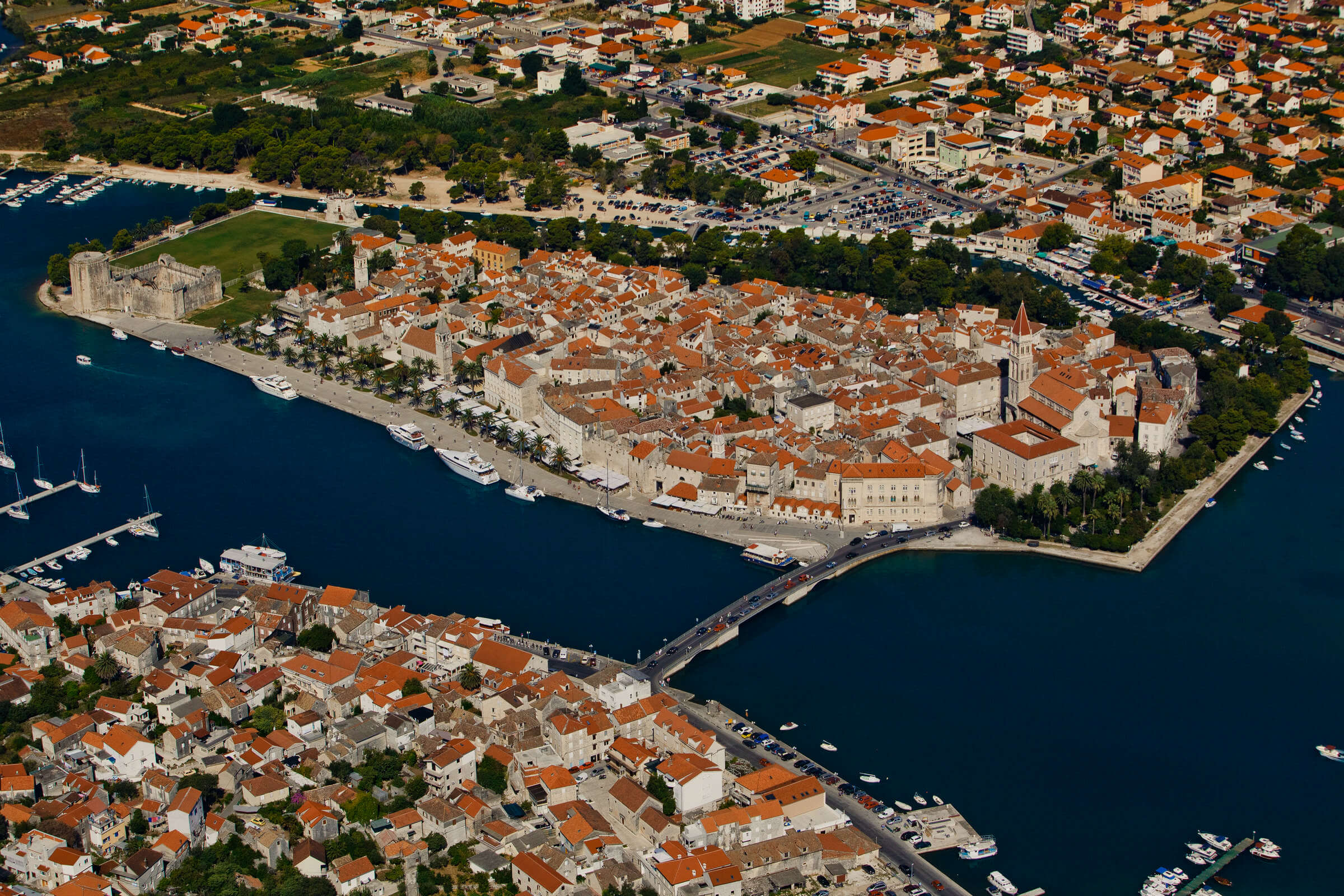
Photo: Mario Romulić
Trogir is a unique example in the history of European architecture and is the city with the largest number of signs or stone markings in Europe. Each brand has its own meaning. Some of them mark the end of construction, some represent the personal signature of the master, and some are engraved votive prayers. The masters also carved games in stone, such as chess, which was used as entertainment during their construction break.
Source: Trogir Tourist Board
Roman Amphitheatre in Solin
At the westernmost point of Solin (Salona) lies the most recognizable building of Roman architecture, the Amphitheatre, in the second half of the second century A.D. The remains of such an imposing Roman amphitheater indicate that gladiator fights were held in the city of Salona just as in other parts of the Roman empire, until the fifth century when they were banned.
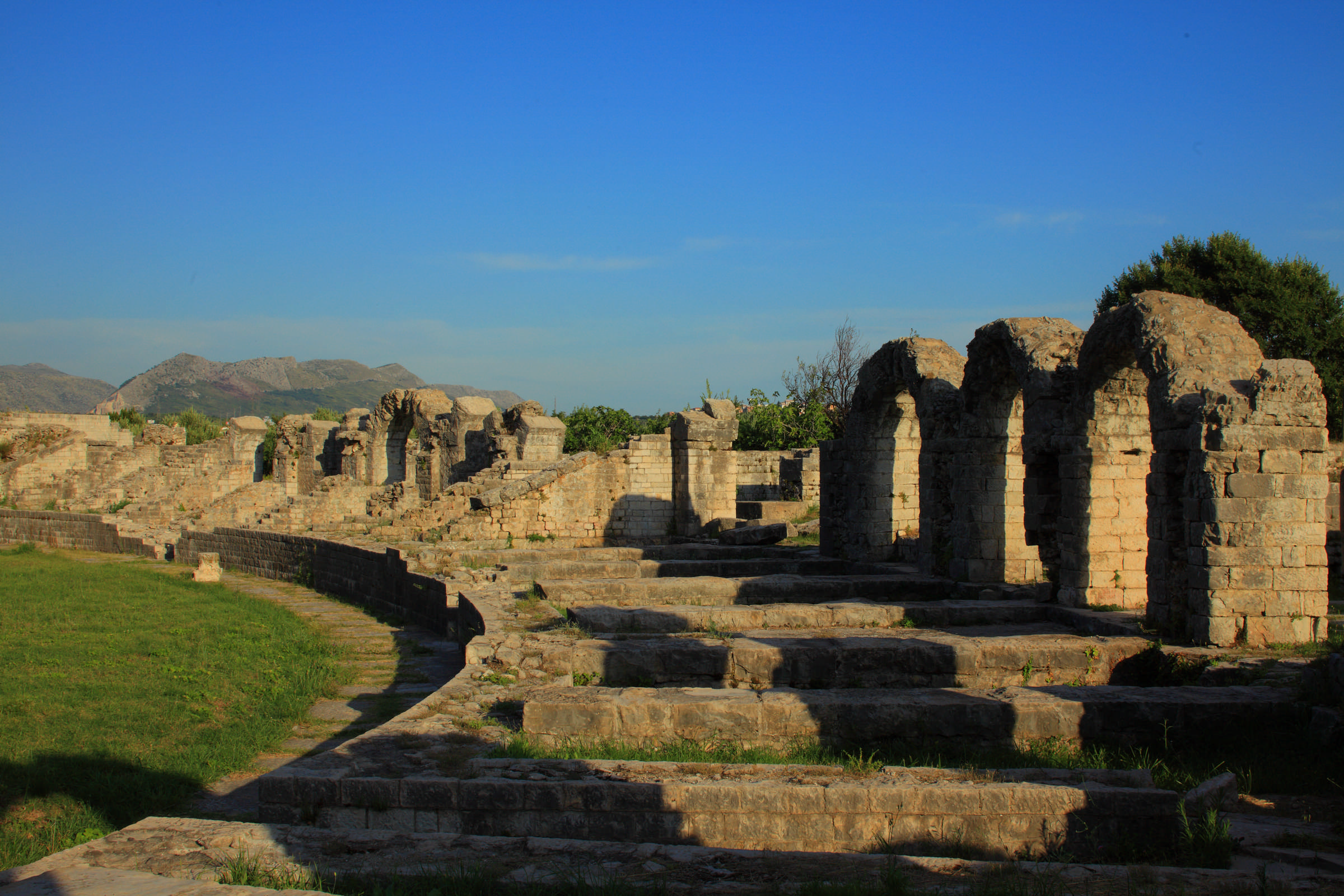
Photo: Mario Romulić
The building was ellipsoidal in shape, with three floors on the south side and one floor on the north side, which was conveniently laid down on a natural hillside. Despite its relatively small size (125 by 100 meters outer shell and 65 by 40 meters the arena), the Salonitan amphitheater could have been occupied by 15,000 up to 18,000 spectators. The auditorium was divided into three tiers, the lower two with seats and the upper one for standing.
Source: Solin Tourist Board
Diocletian's Palace in Split
Diocletian's Palace is one of the best-preserved monuments of Roman architecture in the world. The Emperor's Palace was built as a combination of a luxury villa - a summer house and a Roman military camp (castrum), divided into four parts with two main streets. The southern part of the Palace was intended for the Emperor's apartment and appropriate governmental and religious ceremonies, while the north part was for the Imperial guard - the military, servants, storage, etc.
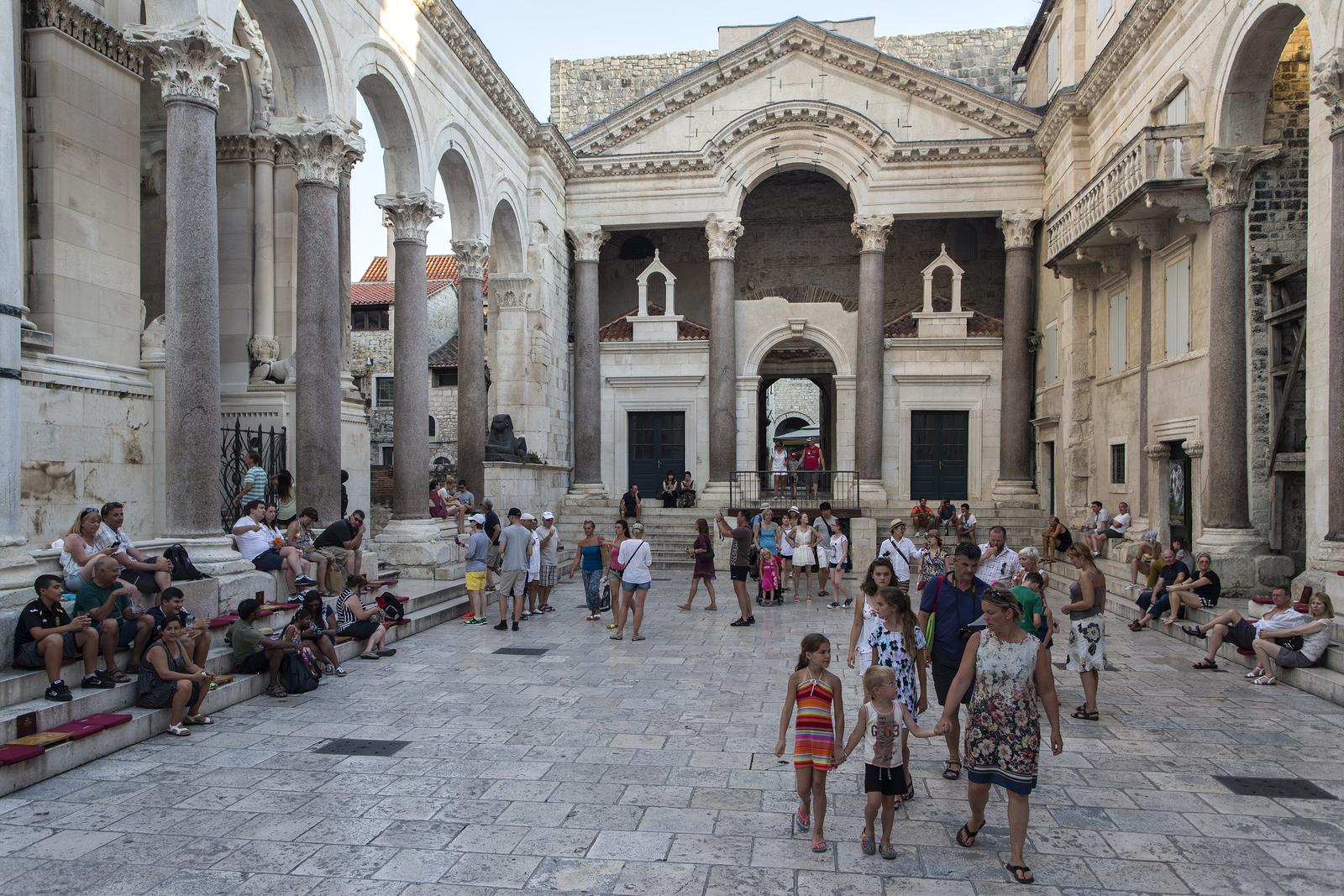
Photo: Davor Puklavec/PIXSELL
The Palace is a rectangular building (approximately 215 x 180 meters) with four large towers at the corners, doors on each of the four sides, and four small towers on the walls. The lower part of the walls has no openings, while the upper floor is open with a monumental porch on the south and halls with grand arch windows on the other three sides. Over the centuries the Palace inhabitants, and later also the citizens of Split adapted parts of the palace for their own requirements, thus the inside buildings, as well as the exterior walls with the towers, significantly changed the original appearance, but the outlines of the Imperial Palace are still very visible.
Source: Split Tourist Board
Walls of Ston
The walls of Ston were built in 1333 when Ston became a part of the Republic of Dubrovnik. Their purpose was to defend the Republic and the peninsula. Dubrovnik government in 1335 and amended in 1370 and is considered one of the best planned and best structured cities in Europe. The walls of Ston were a massive architecture and construction feat. Originally 7000-meters long (22 965 ft.), they consist of several parts; the Ston city walls, the Mali Ston city walls, and the Big wall with its three forts.
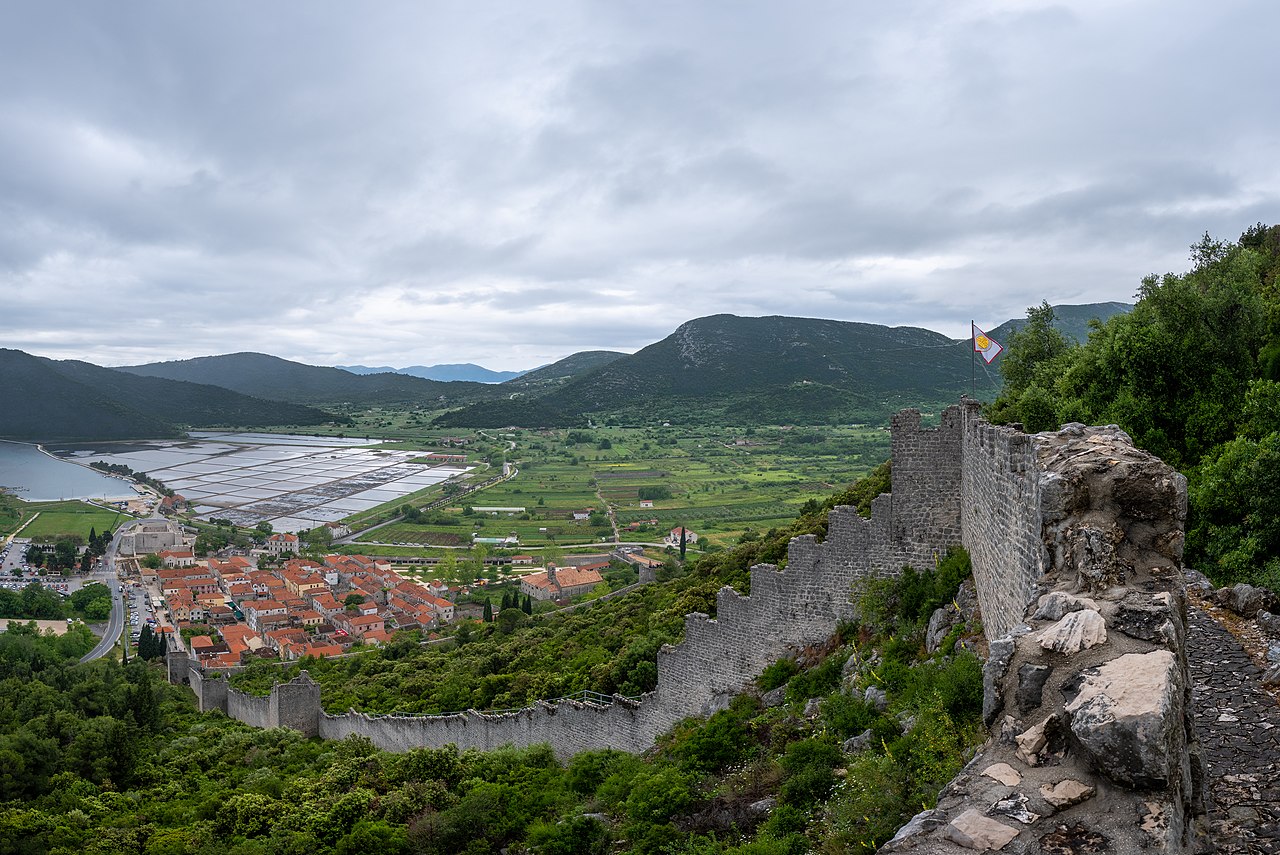
Photo: Jules Verne Times Two/Wikimedia Commons
Its forts and towers are strengthened by 10 round and 31 square flanking towers and 6 semi-circular bastions. The walls were last used in the 19th century for the defense of the city and salt pans, and today they are priceless monuments of immense architectural and cultural value. You can visit the Walls during the whole year. Take a walk around the city of Ston (in roughly 20 minutes) and from Ston to Mali Ston (in roughly 40 minutes).
Source: Ston Tourist Board
Walls of Dubrovnik
The successful development of Dubrovnik in the past was conditioned primarily by its favorable geographical position, and by an economy based on maritime and merchant activities. When entering the Adriatic Sea, Dubrovnik is the first island-protected port on the maritime route going from east to west, with quick access to the hinterland by way of the Neretva Valley. Latest archaeological research has shown that a settlement dating to the 6th century or probably even earlier existed under today's city. It expanded with the arrival of the Croats in the 7th century, following the abandonment of ancient Epidaurus (today's Cavtat).
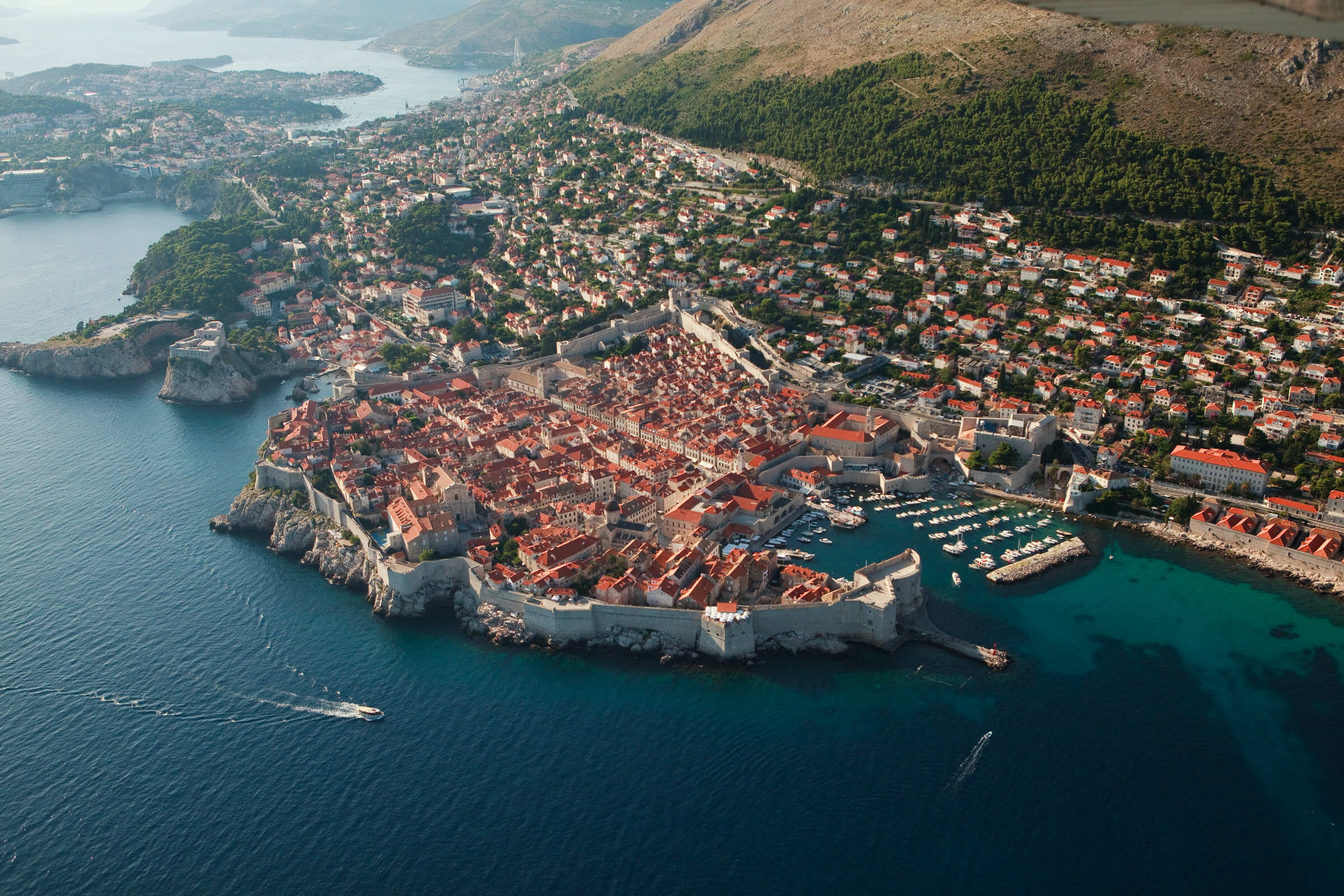
Photo: Mario Romulić
The intensification of traffic between the East and West both during and after the Crusades resulted in the development of maritime and mercantile centers throughout the Mediterranean and the Adriatic Sea in the 12th and 13th centuries. Dubrovnik was one of them. The Zadar Treaty in 1358 liberated Dubrovnik from Venetian rule, and it was crucial to the successful furthering of its development.
For more on travel in Croatia, follow TCN's dedicated page.
Miroslav Tuđman Helped Shape Croatian Society, Says Plenković
ZAGREB, 31 January 2022 - Opening an online seminar on Miroslav Tuđman on Monday, Prime Minister Andrej Plenković said that Tuđman was among the researchers and politicians who in the past 30 years had shaped Croatian society and participated in the adoption of key decisions.
The two-day event, organised by the Ivo Pilar Institute of Social Sciences and the St. George association, is being held on the occasion of the first anniversary of the death of the prominent researcher and politician and founder of Croatia's security-intelligence community.
Plenković said Tuđman was one of the last actors on the Croatian political scene who had detailed knowledge of the events since 1990 and before, which, he said, had helped him analyse, in a truth-loving way, processes and phenomena the country had been faced with.
He said Tuđman's most important contribution was the establishment of the national security-intelligence system, his role in strengthening relations between Croatia and Bosnia and Herzegovina and the equality of BiH Croats in relation to the other two biggest ethnic groups, as well as his role in the 1991-95 Homeland War.
"He participated, along with his father, Croatia's first president Franjo Tuđman, in all key events and is definitely one of the Croatian politicians who formed and shaped society and participated in the adoption of key strategic decisions that secured Croatia's freedom, democracy and integration with the EU and NATO," said Plenković.
As a member of parliament in several terms, Tuđman headed Croatia's delegation at the NATO Parliamentary Assembly and contributed to global security also beyond that transatlantic organisation, he said, adding that with his research Tuđman defended "the truth about his father".
With books, facts and arguments he countered attacks by forgers of Croatia's modern history on the legacy of the first Croatian president, said Plenković, pointing also to Tuđman's political engagement in the HDZ party.
Tuđman was among the founders of the Ivo Pilar institute 30 years ago and the founder of the St. George association", a non-government, non-party and non-profit association founded to promote development and research in the field of international, homeland, national and corporate security, it was said at the seminar.
He was the editor of the "National security and the future" magazine for 21 years and was a long-time professor at the Zagreb Faculty of Humanities and Social Sciences' Department of Information and Communication Sciences, it was said.


